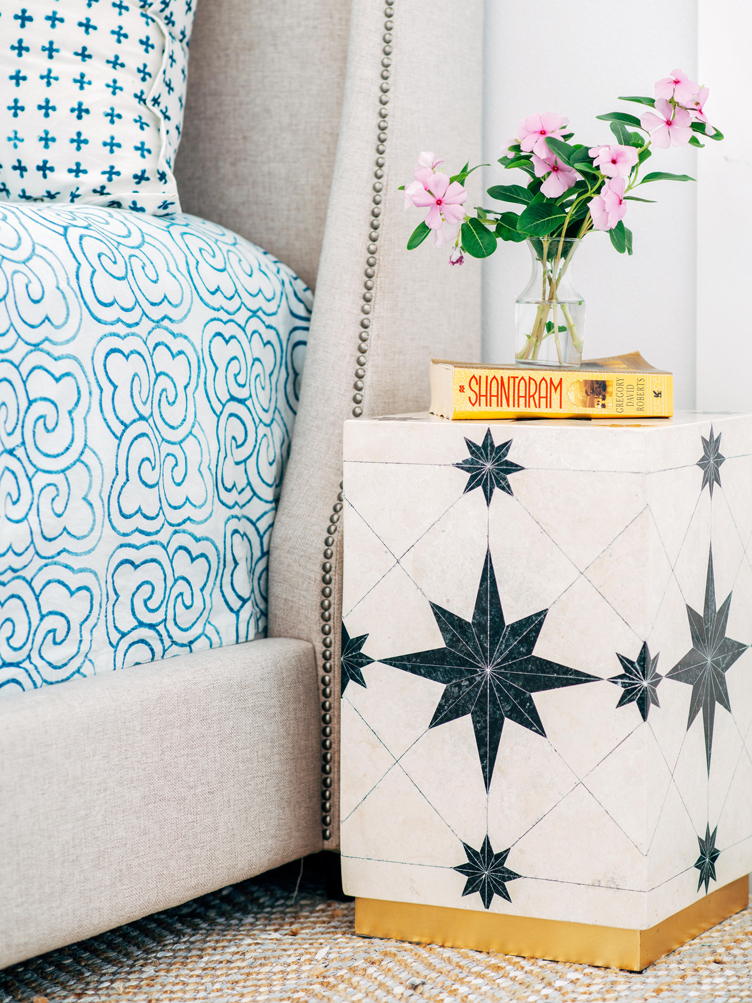Like any other bedroom furniture, nightstands come in all shapes, styles and sizes. Once you begin your search, you can see how vast and varied the assortment is, making it challenging to settle on the perfect look to enhance your room. Your design style or material preferences are not the only factors to consider; dimensions and proportions play as much of a role in your decision-making process. Let’s break down what you should know about selecting the right nightstand to create the bedroom of your dreams.
Shop the Look
Product_id 3548460 not found

Proportion and Dimensions
Start with evaluating your bedroom; how much space do you have to work with? Measure the wall length of your room as well as the width of your bed to determine what size nightstands fit in your room. You may have more or less area than you assumed, or you may decide your room doesn’t need a symmetrical look if you don’t center your bed against a wall.
Why is this important? Your nightstands may not fit in your room with the rest of your furniture or look too small against a large wall. It’s a delicate balance, but your design choices will all make sense when you understand how dimensions figure into the equation. Measure each of these dimensions to get a better feel of the size nightstand your room can accommodate.
Height
Goldilocks had a good point: you don’t want your nightstand to be too short or too tall. Interior designers suggest using the height of your bed as a guide. For example, a mid-century modern platform bed may look awkward between two tall nightstands, while a traditional four-post bed may make it impossible for you to reach short nightstands. A good rule of thumb is to measure from the floor to the top of the mattress, including any box spring or mattress topper. Look for a nightstand within three inches of that height.

Width
This measurement is all about proportion. You wouldn’t want to use two three-foot nightstands on either side of a twin bed any more than you would an ultra-narrow nightstand next to a California king. Think about the other pieces of furniture in your bedroom and consider the scale in relation to the nightstands you are contemplating. Do they look good together or out of place? Would one nightstand be more appropriate?
Depth
The depth of your nightstand should take into account the function you need. Do you like a minimal style with no clutter next to the bed, or do you want space for a bedside lamp, a stack of books, a clock and more? Stick with a nightstand that gives you plenty of room for your bedtime routine. You may even want to think about how many drawers or shelves can hold some of those essentials you typically leave on top of your nightstand. With better storage, you may prefer a shallow stand because your surface is clear of clutter.

Style and Texture
Now that you have a better idea of the right proportions, you can switch gears and consider style and materials. Go back to the rest of your bedroom or home to decide how consistent you want your design elements to be. Are you a modern farmhouse fan, or do your tastes run more eclectic? While you can play around with finishes, you may want to stick with a general style for a cohesive, elegant room that relaxes you.
Most nightstands feature wood, metal, glass, wicker, rattan or a combination of several. Then you have finishes to explore, like chrome or gold, mahogany or maple, even painted or natural. Focus on the styles you like and then narrow your choices about how they blend with your other pieces.
Balance and Symmetry
Another aspect of style when choosing a nightstand for your boudoir is whether you like formal or casual looks. Formal rooms turn to classic design elements for balance—for instance, a large traditional bed pairs well with a similar nightstand style, while modern nightstands fit well with a sleek, minimal look.
If you feel more at home with casual comfort, you can mix and match for more character. Too much matchy-matchy may not be for you, especially if your current furnishings are not in the same style or from the same era. Mixing vintage treasures with traditional or modern bedroom furniture can speak more to your personality. Symmetry can come from a pair of bedside lamps or wall sconces if you want to blend into a transitional style.

Play and Innovate
Who said what you put next to your bed needs to be a nightstand? Anything you put at your bedside can serve as a nightstand, even a chest of drawers, chair, floating shelf or bar cart. Get creative and explore your options if the selection you see doesn’t speak to you. Choosing an alternative to a traditional nightstand can make a bold statement or give you better flow and function, especially in a small space.
Ultimately, the right nightstand for your bedroom is the one that is the perfect combination of form and function. Your bedroom should be a stress-free zone where you can relax and rest, and if your nightstands don’t work for you, you may not realize that peaceful oasis you deserve.
Once you have your measurements in hand, visit Chairish to shop for nightstands. Our curated selection of unusual finds and treasures exists beyond the scope of just a few design styles or mass-produced pieces. If you want furniture and home décor that you can’t find just anywhere, browse our site for those rare gems with heart that transform a house into a home.
Shop the Look
Product_id 3548460 not found















